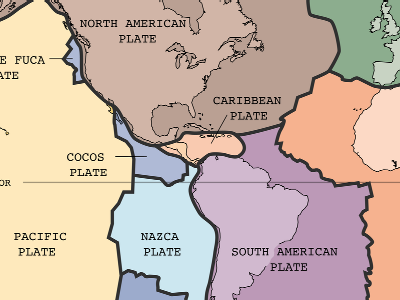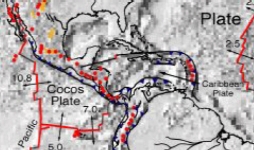Revision as of 13:30, 25 June 2009
Criticism
Critics argue that the "three days of darkness" in the New World following Christ's death is implausible.
Source(s) of the Criticism
Response

The
LGT model for the Book of Mormon situates Book of Mormon lands in the Caribbean tectonic plate, and intersection of multiple tectonic plates and consequently of much volcanism and seismic activity.
The three days of darkness is consistent with a period of intense volcanism. This explanation of the darkness has been particularly popular among those who advocate a limited geographical model of the Book of Mormon. Most LGT models place Book of Mormon lands in central America; this area is well-known for active seismic activity.
One author suggested:
- The basic cause of the destruction was a tremendous seismic upheaval.
- Numerous destructive mechanisms were involved, but rain was not one of them.
- The accompanying period of darkness was caused by an immense local cloud of volcanic ash.
- The unprecedented lightning was due to electrical discharges within the ash cloud.
- The intense thunder was due both to the lightning and to the rumbling of the earth due to seismic movements.
- The vapor of darkness (1 Nephi 12:5; 19:11) and the mist of darkness (3 Nephi 8꞉20) were volcanic ash and dust stirred up by the quaking of the ground.[1]

The intersection of the Cocos and Caribbean plates results in multiple volcanoes (shown in red dots on this USGS map) through central America.
Also:
- The inability to ignite the exceedingly dry wood is interesting in view of the fact that a few people are also described as dying from suffocation during the period of destruction which preceded the period of darkness (3 Nephi 10:13). This suggests that in some regions the concentration of dense volcanic gases (carbon dioxide and sulfur dioxide) at ground level was sufficient to prevent igniting of the kindling and to cause suffocation. The uncle of Pliny died of suffocation as a consequence of a volcanic eruption.
- James Baer notes that volcanic eruptions could have accompanied the violent earthquake described in 3 Nephi. He notes that these would have made the atmosphere dark with dust and cinders and would have released carbon monoxide, carbon dioxide, and sulfurous gases, which would have been suffocating and could have made fire kindling impossible.
- Another mechanism, however, seems an equally likely explanation of the inability to ignite the dry tinder. If one assumes that sparks from flint were the common method of starting fires, then the heavy ash fall could have been effective in preventing ignition. This heavy ash fall also offers a likely explanation for the terms mist of darkness and vapor of darkness used in 1 Nephi 12:4–5.[2]
Dating evidence
Furthermore, ice core data is consistent with a major volcanic event at the time of Christ's death, within the margin of error provided by the dating measurements, though it is not at present possible to determine the location of these eruptions.[3]
Conclusion
3 Nephi 8꞉5-25 provides a detailed description of a massive volcanic and seismic eruption. Such details are precise for both ancient and modern accounts, though they would have been unknown to Joseph Smith.
Endnotes
- [note] Russell H. Ball, "An Hypothesis concerning the Three Days of Darkness among the Nephites," Journal of Book of Mormon Studies 2/1 (1993). [107–123] link
- [note] Russell H. Ball, "An Hypothesis concerning the Three Days of Darkness among the Nephites," Journal of Book of Mormon Studies 2/1 (1993). [107–123] link (italics in original); citing James Baer, "The Third Nephi Disaster: A Geological View," Dialogue: A Journal of Mormon Thought 19 no. 1 (Spring 1986), 129–132.off-site
- [note] Benjamin R. Jordan, "Volcanic Destruction in the Book of Mormon: Possible Evidence from Ice Cores," Journal of Book of Mormon Studies 12/1 (2003). [78–87] link
Further reading
FAIR wiki articles
Three days of darkness in the New World following Christ's death
External links
- Anonymous, "Out of the Dust: When the Day Turned to Night," Journal of Book of Mormon Studies 10/2 (2001). [66–67] link
- Russell H. Ball, "An Hypothesis concerning the Three Days of Darkness among the Nephites," Journal of Book of Mormon Studies 2/1 (1993). [107–123] link
- James Baer, "The Third Nephi Disaster: A Geological View," Dialogue: A Journal of Mormon Thought 19 no. 1 (Spring 1986), 129–132.off-site
- John Gee, "Another Note on the Three Days of Darkness," Journal of Book of Mormon Studies 6/2 (1997). [235–244] link
- Benjamin R. Jordan, "Volcanic Destruction in the Book of Mormon: Possible Evidence from Ice Cores," Journal of Book of Mormon Studies 12/1 (2003). [78–87] link
- Bart J. Kowallis, "In the Thirty and Fourth Year: A Geologist's View of the Great Destruction in 3 Nephi," Brigham Young University Studies 37 no. 3 (1997), 137–190. PDF link
- John A. Tvedtnes, "Historical Parallels to the Destruction at the Time of the Crucifixion," Journal of Book of Mormon Studies 3/1 (1994). [170–186] link
Printed material
- Joseph L. Allen, Exploring the Lands of the Book of Mormon (Orem, UT: SA Publishers, 1985), 230. ISBN 0842523847.
- Hugh W. Nibley, Since Cumorah, 2nd edition, (Vol. 7 of the Collected Works of Hugh Nibley), edited by John W. Welch, (Salt Lake City, Utah : Deseret Book Company ; Provo, Utah : Foundation for Ancient Research and Mormon Studies, 1988), 223. ISBN 0875791395.


